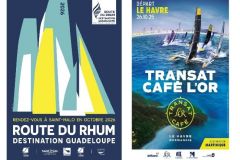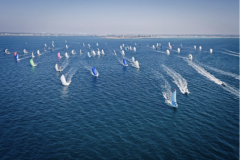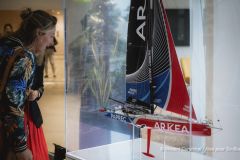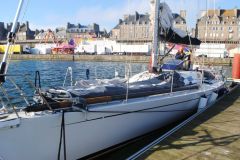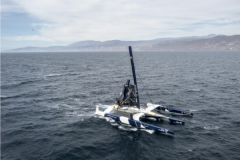Every race is governed by the racing instructions. They explain the rules to follow. Here are those to follow for the Route du Rhum.
1 - The starting line
The starting line, 3 miles long, is anchored perpendicular to the course axis in the direction of the Cap Fréhel gate. It is divided into four parcels from north to south, to accommodate the boats according to their speed and maneuverability. The trimarans are in the north and the rest of the fleet in the south.
The start is given after an 8-minute countdown and the technical teams must leave the boat 4 minutes before the start. So at 1:56 pm, the skipper must be "solo" and all the accompanying people must have left the boat, picked up by the team's semi-rigid boats which come as close as possible to the boat, sometimes even throwing themselves into the water in TPS suits.
Finally, at 2 pm sharp, the start is given from the Pont-Aven, flagship of Brittany Ferries. The starting line remains open for 60 minutes and a candidate who has not passed it can return to Saint-Malo and ask the Race Direction for authorization to start again.
In case of crossing the line before the start, the skipper will be penalized 4 hours. For safety reasons, the skipper will not cross the line in Saint-Malo, but will have to complete his penalty before the longitude 20 degrees West (West of Madeira). He will have to inform the race direction of the longitude at which he wants to do it and cross this same point of longitude four hours after having passed it the first time.
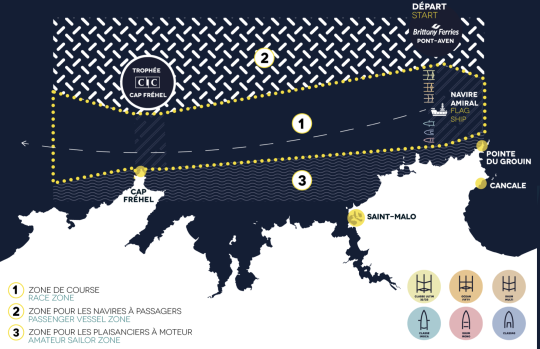
2 - The course
- Starting line
- Cape Fréhel Gate, 16 miles from the start (the first in each class wins the Cape Fréhel Trophy Banque Populaire Grand Ouest)
- Guadeloupe (including the islet of Tête à l'Anglais) to go around to port
- Basse âeuros Terre buoy, in the Saintes channel (30 miles from the finish line) to be left to starboard
- Landing buoy Pointe-à-Pitre to port
- Finish line
- Theoretical distance: 3542 miles
Prohibited areas and DSTs (Traffic Separation Devices) to be avoided mark out the course of 3,452 nautical miles.
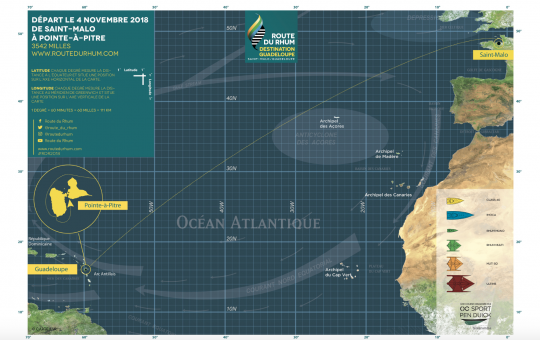
3 - Stopovers
Within a radius of 150 miles after the start âeuros circle covering the whole English Channel, the Scilly Islands and the French coasts up to the latitude of Bordeaux âeuros skippers can make as many stopovers as they wish, without penalty. The replacement of equipment must be submitted to the validation of the organization.
Thereafter, a single technical stopover is accepted and will be penalized by 4 hours. This means that the skipper will have to stop for at least 4 hours.
An exception to the rule is the Ocean Fifty whose class rules allow for an unlimited number of stops.
4 - Routing
Routing is forbidden for IMOCA and Class40 and allowed for the two multihull classes â??Ultimatesâ?? and â??Ocean Fiftyâ?? and the two classes â??Rhumâ?? This means that the skippers concerned can be helped by a router on the weather and the strategic route to follow.

5 - Race time limit
The finish line in Guadeloupe will be closed on Sunday, December 4th, 28 days after the start. In case of not crossing the line in time, the skipper will not be classified.
6 - Penalties
Depending on the offences committed, the solo sailors will be penalized. For example, for a passage in a forbidden zone, there is a 4 to 6 hour penalty, for a passage in a DST, there is a 24 hour penalty to disqualification, etc.
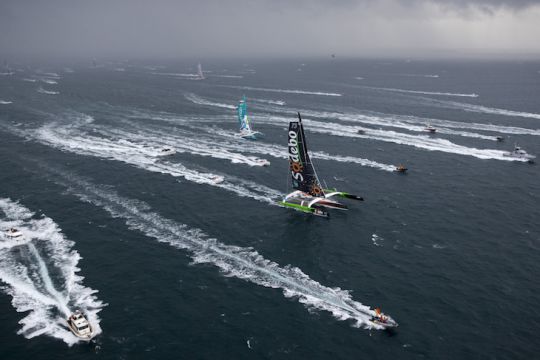
7 - Leads
Some parts of the boat are sealed, i.e. they are sealed and should only be opened at the finish, once the boat has been checked. Here they are:
The propeller shaft of the engine: 4 minutes before the start, the engine can only be used to generate energy for the use of the on-board instruments.
The emergency fuel and water supplies, the life raft, the survival bag, the anchor, etc. must remain closed and in their assigned place. Skippers must not use them to change the weight on board as needed.
8 - Abandonments
The abandonment automatically generates the withdrawal from the race. But the race direction watches over the beacon until the boat is put under cover. Left alone in the open sea, it is a danger for the other sailors.




